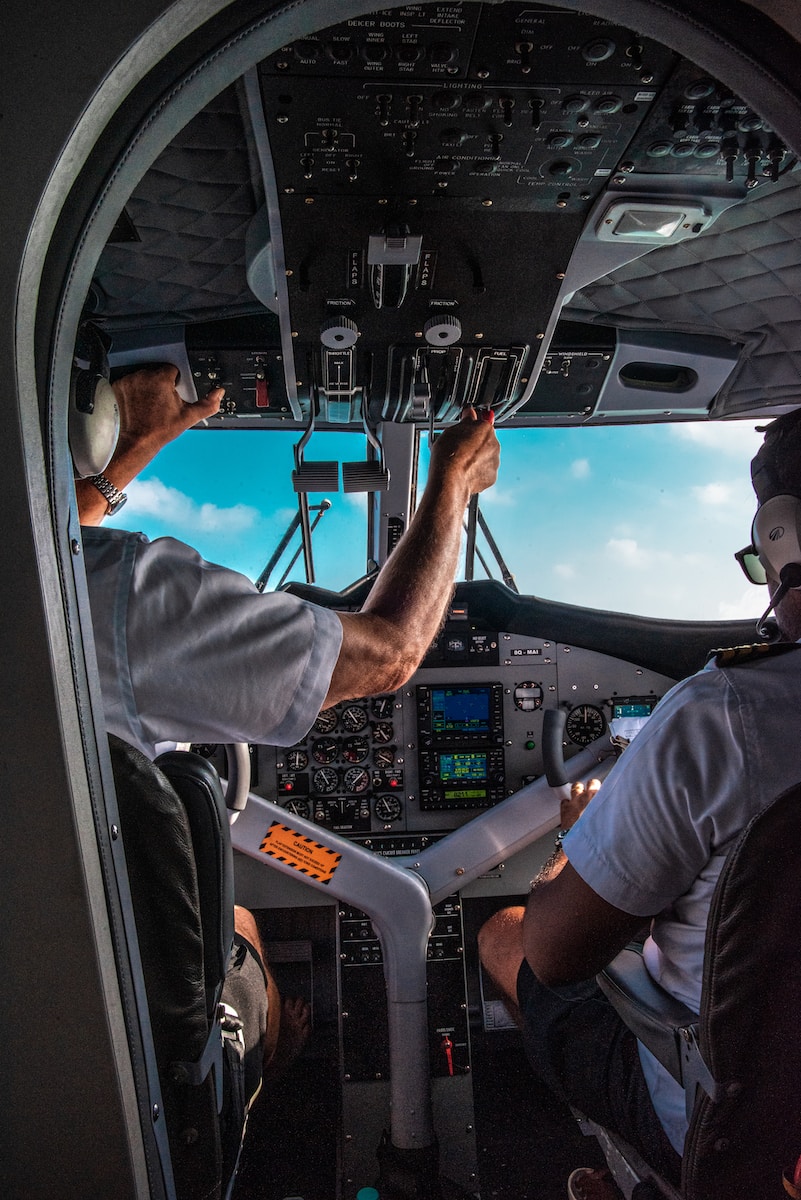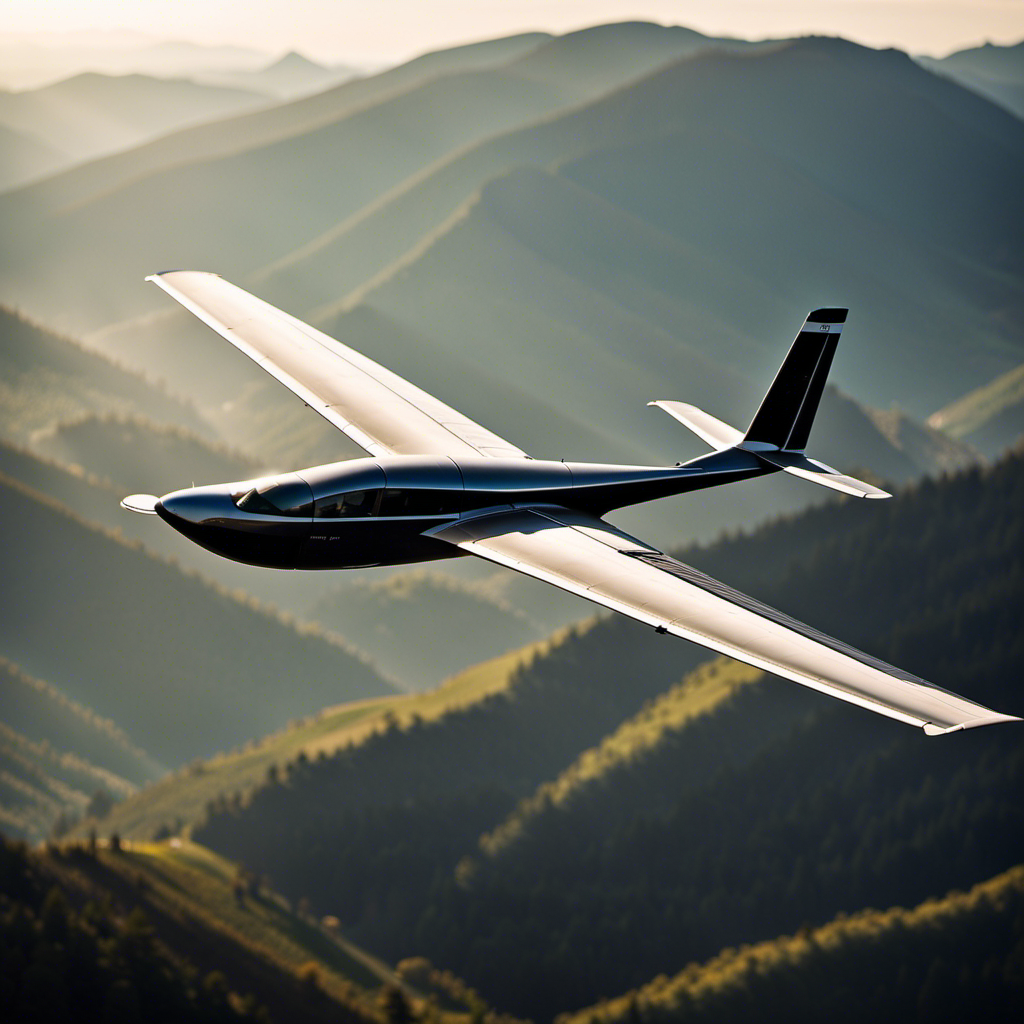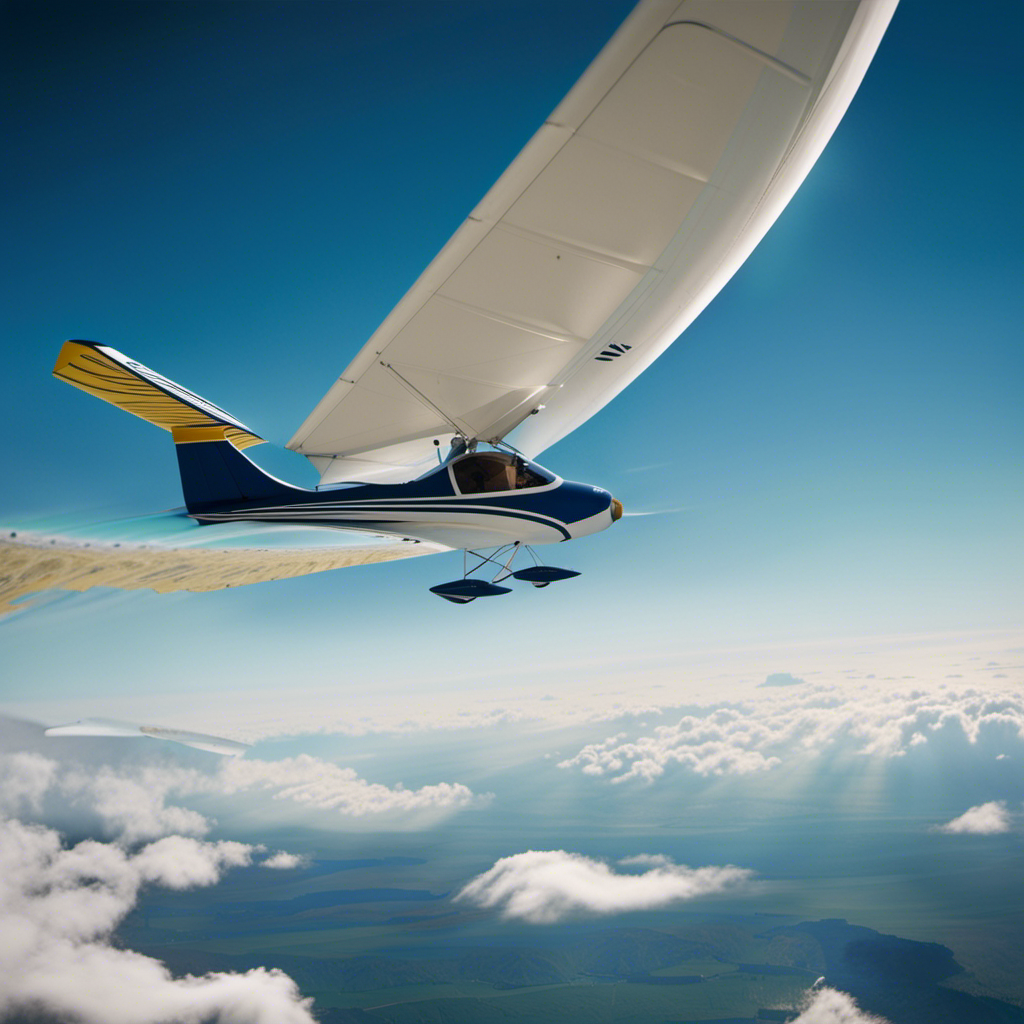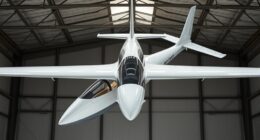Have you ever dreamed of soaring through the sky, feeling the wind in your hair, and embracing complete freedom? Let me introduce you to a remarkable flying contraption that can turn this fantasy into reality: the motor glider.
With its unique combination of a glider’s graceful glide and a motor’s power, this aircraft offers an exhilarating flying experience like no other. In this article, we will explore the advantages and disadvantages of owning a motor glider, how to choose the right one for you, and much more.
So fasten your seatbelts and get ready to explore the world of motor gliders!
Key Takeaways
- Regular inspections, oil changes, and repairs are essential for smooth and safe operation of a motor glider.
- Joining a motor glider club provides access to experienced pilots for guidance and advice.
- Motor gliders offer opportunities for group flights, competitions, and events to enhance flying skills.
- Checking weather conditions, regular engine maintenance, and staying updated with manufacturer’s maintenance procedures are important for motor glider pilots.
What is a Motor Glider?
A motor glider is a unique aircraft that combines the features of both a motorized airplane and a glider. It is equipped with an engine, which allows it to take off and climb like a traditional airplane. However, once it reaches a desired altitude, the engine can be shut off, and the aircraft can glide through the air using its wings, just like a glider.
This dual functionality gives motor gliders the advantage of being able to fly for longer periods of time without the need for continuous engine power. In terms of performance, motor gliders are known for their efficient fuel consumption and the ability to soar in thermals, which allows them to cover long distances and makes them popular for cross-country flights.
With these features and performance capabilities, owning a motor glider provides pilots with a versatile and enjoyable flying experience.
Advantages of Owning a Motor Glider
One advantage of owning a motor glider is that it allows for more flexibility in travel plans. With a motor glider, I can easily reach remote destinations that are not accessible by traditional airplanes.
The benefits of owning a motor glider include:
- Versatility: Motor gliders can switch between soaring and powered flight, giving me the freedom to choose the most efficient mode of travel depending on weather conditions and distance.
- Cost-effectiveness: Motor gliders have lower operating costs compared to traditional airplanes, thanks to their efficient engines and ability to glide without using fuel.
- Sightseeing opportunities: The panoramic view from the cockpit of a motor glider provides breathtaking views of the surrounding landscape, allowing me to enjoy the beauty of nature while flying.
Transitioning to the next section, it’s important to consider the potential disadvantages of owning a motor glider.
Disadvantages of Owning a Motor Glider
Transitioning to the potential downsides of owning a motor glider, it’s important to consider the maintenance costs and the limited seating capacity.
While motor gliders offer the unique advantage of combining the features of both a motorized aircraft and a glider, they do come with certain disadvantages.
Firstly, maintenance costs can be quite high for motor gliders due to the complexity of their dual power systems. Regular inspections and servicing are necessary to ensure their safe operation.
Secondly, the limited seating capacity can be a drawback for those who wish to fly with a larger group or carry additional cargo.
These limitations should be carefully considered when deciding if a motor glider is the right choice for you.
Now, let’s explore how to choose the right motor glider for your needs.
How to Choose the Right Motor Glider for You
When choosing a motor glider, it’s important to consider your flying experience and the specific features that meet your needs. Choosing the right model can greatly enhance your flying experience and ensure that you have a safe and enjoyable time in the air. There are several factors to consider when making your decision, such as the type of engine, the wingspan, and the payload capacity. To help you make an informed decision, I have created a table below outlining some popular motor glider models and their key features:
| Model | Engine Type | Wingspan (m) | Payload Capacity (kg) |
|---|---|---|---|
| Model A | 2-stroke | 12 | 200 |
| Model B | 4-stroke | 14 | 300 |
| Model C | Electric | 10 | 150 |
Training and Licensing Requirements
To operate a motor glider safely, it’s important to understand the training and licensing requirements. Here are three key things to consider:
-
Pilot Qualifications: Before flying a motor glider, you must hold a valid pilot’s license. In most countries, this requires completing a minimum number of flight hours and passing written and practical exams. Additionally, some jurisdictions may have specific endorsements or ratings for motor gliders that you need to obtain.
-
Flight Training: To gain the necessary skills and knowledge, you will need to undergo flight training specific to motor gliders. This training typically includes ground instruction on aerodynamics, glider systems, and emergency procedures. You will also receive hands-on flight training, where you’ll learn how to handle the unique characteristics of motor gliders, such as using the engine for takeoff and landing.
-
Licensing Requirements: Once you have completed the necessary training, you will need to pass a licensing exam specific to motor gliders. This exam will test your understanding of motor glider operations and safety procedures. After successfully passing the exam, you will be granted a motor glider endorsement on your pilot’s license, allowing you to operate these aircraft.
Understanding the pilot qualifications and flight training required to operate a motor glider is crucial for ensuring a safe and enjoyable flying experience.
Now, let’s delve into the costs of owning a motor glider.
Costs of Owning a Motor Glider
Owning a motor glider can be expensive, but there are ways to manage the costs. When considering the costs of owning a motor glider, it is important to compare the initial purchase price, as well as the long-term maintenance costs.
Motor gliders can vary in price depending on factors such as brand, model, and equipment. It is advisable to research and compare prices from different manufacturers or sellers to ensure you get the best deal.
Additionally, long-term maintenance costs should be taken into account. This includes regular inspections, repairs, and any necessary upgrades. It is important to budget for these costs to ensure the continued safe and efficient operation of your motor glider.
By carefully considering the cost comparison and long-term maintenance costs, you can make an informed decision about owning a motor glider.
Transitioning into the subsequent section about flying and operating a motor glider, it is important to understand the responsibilities and skills required to safely enjoy this type of aircraft.
Flying and Operating a Motor Glider
If you’re interested in flying and operating a motor glider, it’s important to understand the necessary skills and responsibilities involved.
Flying techniques are crucial when it comes to safely maneuvering a motor glider. You need to learn how to take off, land, and navigate through the air using the glider’s engine and wings.
Additionally, maintenance and repairs should not be overlooked. As the pilot, you are responsible for keeping the motor glider in good condition. Regular inspections, oil changes, and repairs are essential to ensure the glider operates smoothly and safely.
Being knowledgeable about the inner workings of the glider will also help you troubleshoot any issues that may arise during flights.
Joining a Motor Glider Club or Association
Joining a motor glider club or association is a great way to connect with other enthusiasts and expand your knowledge and experience in the world of motor gliding. It provides a platform to meet like-minded individuals who share your passion for motor gliders.
Here are a few reasons why joining a motor glider club is beneficial:
- Access to a supportive community of experienced motor glider pilots who can provide guidance and advice.
- Opportunities to participate in organized group flights, competitions, and events, which can enhance your flying skills and create lasting memories.
Additionally, joining a motor glider club allows you to find motor glider enthusiasts who can become your flying buddies. You can share your experiences, exchange tips, and even plan exciting trips together. Being part of a club or association also opens doors to resources such as training programs, maintenance facilities, and access to different types of motor gliders.
Now, let’s delve into real pilot experiences and testimonials to gain further insight into the world of motor gliding.
Real Pilot Experiences and Testimonials
When it comes to personal stories and insights, there is no shortage of valuable information from experienced motor glider pilots. Their first-hand accounts can provide a wealth of knowledge and understanding about the joys and challenges of flying a motor glider.
Additionally, these pilots can offer valuable tips and advice based on their own experiences, helping aspiring motor glider pilots navigate the unique aspects of this type of aircraft.
Personal Stories and Insights
Have you ever wondered what it’s like to fly a motor glider? I have had the opportunity to pilot a motor glider on several occasions, and I must say, it is a truly remarkable experience.
The feeling of soaring through the sky with the engine turned off, relying solely on the power of the wind and thermals, is exhilarating.
One of the main advantages of flying a motor glider is its versatility. It offers the best of both worlds, combining the ability to take off and land on a runway like a traditional aircraft, while also having the capability to glide like a sailplane.
However, there are some drawbacks to consider. The engine adds weight and can limit the glider’s performance compared to a pure sailplane. Additionally, the cost of maintenance and fuel for the engine should be taken into account.
In the next section, we will explore some tips and advice from experienced motor glider pilots to help you make an informed decision.
Tips and Advice from Experienced Motor Glider Pilots
One important tip from experienced pilots is to always check the weather conditions before taking a motor glider flight. Weather plays a crucial role in determining the safety and success of your flight.
Here are some maintenance tips and insights based on my experiences as a motor glider pilot:
- Regularly inspect and maintain the engine to ensure it is in peak condition.
- Keep the glider clean and free from debris to reduce drag and optimize performance.
- Check and secure all control surfaces for any signs of wear or damage before every flight.
- Stay updated with the latest maintenance procedures and guidelines provided by the manufacturer.
By following these tips, you can ensure that your motor glider is well-maintained and ready for safe and enjoyable flights.
Now, let’s move on to the final considerations and conclusion, where we will discuss other important factors to consider before choosing a motor glider.
Final Considerations and Conclusion
In summary, the motor glider can be a great choice for those seeking versatility and efficiency in their flying experience.
When making the decision to purchase a motor glider, there are a few final considerations to take into account.
Firstly, it is important to consider the cost. Motor gliders tend to be more expensive than traditional gliders due to the additional engine and equipment.
Additionally, it is crucial to evaluate your flying goals and needs. If you are looking for a recreational aircraft that allows you to soar through the skies with the option of using the engine for added convenience, then a motor glider may be the perfect fit.
Lastly, don’t forget to factor in maintenance and training requirements to ensure a safe and enjoyable flying experience.
Frequently Asked Questions
Are motor gliders allowed to fly in the same airspace as other aircraft?
Yes, motor gliders are allowed to fly in the same airspace as other aircraft. They are designed with safety features and have good performance capabilities to ensure smooth coexistence with other aircraft in the sky.
Can I use a motor glider for long-distance flights?
Yes, you can use a motor glider for long-distance flights. They are fuel efficient and can cover significant distances. The combination of gliding and engine power allows for extended travel without the need for frequent refueling stops.
Do motor gliders require regular maintenance and inspections?
Motor gliders require regular maintenance and inspections to ensure safety. From engine checks to airframe inspections, these tasks are essential. Neglecting them could lead to serious consequences. So, stay on top of motor glider maintenance and inspections!
Are there any weight restrictions for passengers or cargo in a motor glider?
Yes, weight restrictions and cargo limitations exist in motor gliders. These restrictions ensure that the aircraft operates safely and within its designed limits. It is important to adhere to these guidelines for the safety of all on board.
Are there any restrictions on flying a motor glider at night?
Yes, there are night flying restrictions for motor gliders due to safety considerations. It is important to be aware of these restrictions and follow them to ensure a safe flying experience.
Conclusion
In conclusion, owning a motor glider can be a thrilling and fulfilling experience for aviation enthusiasts. The advantages of owning a motor glider, such as the ability to soar through the skies and explore new horizons, are unmatched.
However, it’s important to consider the disadvantages, such as the cost of maintenance and training requirements. With the right training and licensing, operating a motor glider can be a rewarding endeavor.
So, ask yourself, are you ready to take to the skies and experience the freedom of flight?









